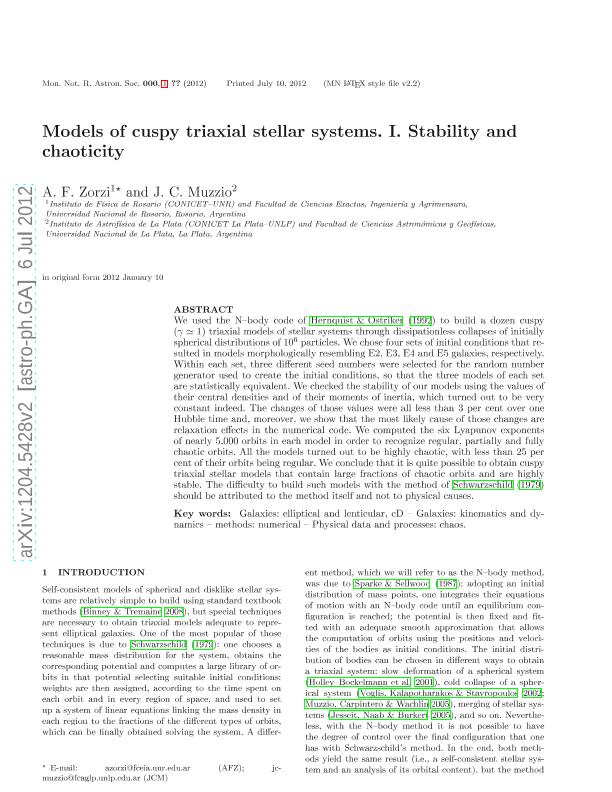Artículo
Models of cuspy triaxial stellar systems, I: stability and chaoticity
Fecha de publicación:
06/2012
Editorial:
Wiley Blackwell Publishing, Inc
Revista:
Monthly Notices of the Royal Astronomical Society
ISSN:
0035-8711
Idioma:
Inglés
Tipo de recurso:
Artículo publicado
Clasificación temática:
Resumen
We used the N-body code ofWe used the N–body code of Hernquist & Ostriker (1992) to build a dozen cuspy (γ ≃ 1) triaxial models of stellar systems through dissipationless collapses of initially spherical distributions of 106 particles. We chose four sets of initial conditions that resulted in models morphologically resembling E2, E3, E4 and E5 galaxies, respectively. Within each set, three different seed numbers were selected for the random number generator used to create the initial conditions, so that the three models of each set are statistically equivalent. We checked the stability of our models using the values of their central densities and of their moments of inertia, which turned out to be very constant indeed. The changes of those values were all less than 3 per cent over one Hubble time and, moreover, we show that the most likely cause of those changes are relaxation effects in the numerical code. We computed the six Lyapunov exponents of nearly 5,000 orbits in each model in order to recognize regular, partially and fully chaotic orbits. All the models turned out to be highly chaotic, with less than 25 per cent of their orbits being regular. We conclude that it is quite possible to obtain cuspy triaxial stellar models that contain large fractions of chaotic orbits and are highly stable. The difficulty to build such models with the method of Schwarzschild (1979) should be attributed to the method itself and not to physical causes.
Palabras clave:
Eliptical Galaxies
,
Kinematics
,
Numerical Methods
,
Physical Data
,
Chaos
,
Dynamics
Archivos asociados
Licencia
Identificadores
Colecciones
Articulos(IALP)
Articulos de INST.DE ASTROFISICA LA PLATA
Articulos de INST.DE ASTROFISICA LA PLATA
Articulos(IFIR)
Articulos de INST.DE FISICA DE ROSARIO (I)
Articulos de INST.DE FISICA DE ROSARIO (I)
Citación
Zorzi, Alejandra Francisca; Muzzio, Juan Carlos; Models of cuspy triaxial stellar systems, I: stability and chaoticity; Wiley Blackwell Publishing, Inc; Monthly Notices of the Royal Astronomical Society; 423; 2; 6-2012; 1955-1963
Compartir
Altmétricas




